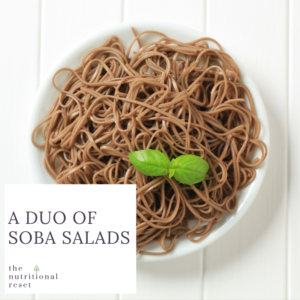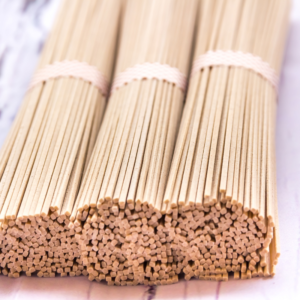
Briefly (teasingly) we had salad weather here in Toronto. It was glorious and, even though the temperatures dipped back down again, it’s reassuring to know that salad days are (almost) here again. I love salads because they are so versatile. Not to mention forgiving. No need to worry about timing things just right so everything’s hot on the table at the same time. In fact, you can often do the prep in stages and then toss everything together at the last minute. Working from home makes this easy. When I need a break from my desk, I pop on over to the kitchen and dice a little of this or that or add some whole grains to the Instant Pot to save time later. With these soba salads, you can even make the noodles ahead of time!
I like to make salads that are all-in-one affairs. They include high quality protein, complex carbs (like whole grains, legumes/pulses or pasta), lots of vegetables (and sometimes fruit) and often nuts or seeds. I’m a big fan of Asian flavours, too, which inspired me to post this Duo of Soba Salads:
Both salads are simple yet super flavourful, with ginger, citrus, hoisin and miso accents. Locally grown romaine and carrots add delectable crunch to the first salad while spring asparagus features in the second. Super-nutritious, 100% buckwheat soba is at the heart of both. I hope you enjoy them!
Sign up to my newsletter today to receive the recipes for this Duo of Soba Salads. And read on to learn more about why soba is as healthy as it is tasty.
Soba – for luck and longevity
 Soba is a thin Japanese noodle made from buckwheat. Did you know that eating soba at New Year’s Eve is a Japanese tradition? I learned this from some very good friends (one of whom is Japanese) when we first rang in the New Year together many years ago. Noodles are associated with longevity due to their long shape and eating soba at the onset of the New Year is said to bring luck. It seems that this tradition developed in the mid-Edo period (1603 – 1868). One theory is that the rice-based diet enjoyed by the wealthier classes left them susceptible to beriberi, a condition we now know is caused by vitamin B1 (thiamine) deficiency. Those who ate vitamin B1-rich soba were spared from the disease, which likely contributed to its reputation for luck, as well as longevity.
Soba is a thin Japanese noodle made from buckwheat. Did you know that eating soba at New Year’s Eve is a Japanese tradition? I learned this from some very good friends (one of whom is Japanese) when we first rang in the New Year together many years ago. Noodles are associated with longevity due to their long shape and eating soba at the onset of the New Year is said to bring luck. It seems that this tradition developed in the mid-Edo period (1603 – 1868). One theory is that the rice-based diet enjoyed by the wealthier classes left them susceptible to beriberi, a condition we now know is caused by vitamin B1 (thiamine) deficiency. Those who ate vitamin B1-rich soba were spared from the disease, which likely contributed to its reputation for luck, as well as longevity.
Soba is super-nutritious
Aside from being an excellent source of B1, soba also is an excellent source of the mineral manganese. Just 1 cup of soba noodles provides 21% of your daily requirement. This is good news as both B1 and manganese are important for glucose metabolism. Not to mention, buckwheat is the richest source of D-chiro-inositol, a soluble carbohydrate that can help manage blood sugar levels. Soba is also a good source of fibre, which is important for blood sugar regulation as well as the health of your colon and the bacteria that live in it.
And manganese is essential for the health of your bones. Buckwheat also contains many other minerals key to bone health (including magnesium, phosphorous and potassium). Further, your body can better absorb these minerals as buckwheat is low in phytic acid, which is a common inhibitor of absorption of the minerals found in grains and seeds.
And soba is surprisingly high in protein with 1 cup providing 6 grams of complete protein. Buckwheat is one of the few sources of plant-based proteins that provide all 9 essential amino acids (soy, quinoa, amaranth and hempseed are also notable for this).
Finally, buckwheat may improve the health of your heart as it is high in anti-inflammatory, antioxidant compounds. One of these, rutin, is thought to help keep your blood vessels strong and flexible. There is also evidence that rutin may help lower LDL cholesterol.
So if you don’t already have some in your pantry, why not switch it up for spring with super-nutritious soba? Look for soba made from 100% buckwheat, like this one. Only 100% buckwheat soba is gluten free.
I hope you enjoy this Duo of Soba Salads. Sign up here for the recipes and feel free to share them with your family and friends!